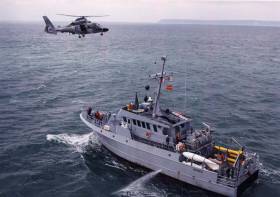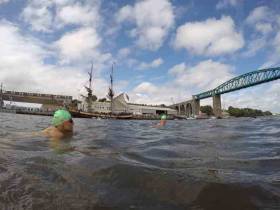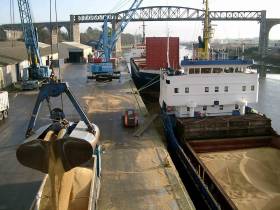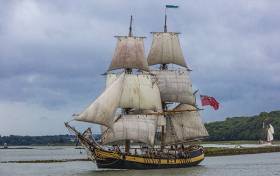Displaying items by tag: Drogheda Port
Drogheda's Maritime Festival Welcomes French Navy
Next weekend, the Irish Maritime Festival in Drogheda Port welcomes the French Navy for the very first time. On Friday, as part of the Parade of Sail (noon on Friday 15th June), three French Sonar Towing Ships will join the Tall Ships, Tug Boats and yachts as they sail up the Boyne. On Saturday and Sunday, festival goers will have a chance to board the vessels and explore.
The 3 Minesweepers, M770 Antares, M771 Altair and M772 Aldebaran were commissioned in 1993. They were ordered to replace the last of the oceanic minesweepers and act as sonar tugs. Built in the Socarenam shipyard in Boulange-sur-Mer, they are similar in shape and size to trawlers. These strong and powerful vessels act as sonar towing ships.
Their role in the French Navy is to provide surveillance for French vessels accessing the Atlantic ports, especially Brest where the Oceanic Strategic Force are positioned. The purpose of their work is to detect and destroy mines in the water that could detonate, damaging vessels and harming crew. They do this by sonar surveillance of the seabed using the DUBM44 sonar system.
They also play a pivotal role in the training of navigation students and engage in public security missions including sea-rescue and wrecks reconnaissance.
Each one is 28m long and nearly 8m wide. They travel at a maximum speed of 11knots and have an engine capable of 3,500 miles, powered by a Baudoin 800 horsepower engine. They travel with 25 crew on board each one.
The names Altair, Antares and Aldebaran are derived from stars in the sky, which have always acted as important markers for maritime navigators. Each of these are the brightest stars in their respective constellations, Aquila, Scorpius and Taurus.
Visitors to the Irish Maritime Festival can visit Altair, Antares and Aldebaran (and the other visiting ships) on Saturday 16th and Sunday 17th June between 12.30-4.30pm. Festival gates open at 11.00am each day and early arrival is recommended to allow sufficient time to visit all the vessels.
The Irish Maritime Festival at Drogheda Port is a family friendly two-day celebration of all things maritime and includes Tall Ships, tugboats, yachts and a maritime education zone. Watch the Water Wags racing up and down the river. Cheer on the 250 participants in The Boyne Swim. Kick back with chilled out tunes on the 2 live music stages and enjoy the delighted of the Boyne Valley in the food zone. For more visit: www.maritimefestival.ie
The Irish Maritime Festival takes place on Saturday 16th and Sunday 17th June and is hosted by Louth County Council in conjunction with Drogheda Port Company. The Festival is sponsored by Virgin Media and supported by Flogas, Glanbia and Fáilte Ireland.
More on the Drogheda Maritime Festival website here
The Irish Maritime Festival will be centre-stage on RTE Nationwide tonight at 7.00pm on RTÉ One as the full half-hour programme is dedicated to its recent staging at Drogheda Port on the River Boyne. It will feature the Boyne Swim, the visiting Tall Ships, the new Fiddle Case Pier, Drogheda’s Sail Training Bursary and all the colour of the festival.
Drogheda’s Boyne Swim Is Back
The Boyne Swim will once again headline the Irish Maritime Festival taking place in Drogheda Port this summer.
200+ competitors will take to the river Boyne to swim the 2.7km tidal route.
Ray Donagh of Drogheda Triathlon Club is one of the Boyne Swim organisers. He explains: "The Boyne Swim takes place at 12.50pm on Saturday 10th June. The first swimmers will pass by the Tall Ships of the Irish Maritime Festival about 25 minutes later with the first swimmer crossing the finish line by 1.25pm."
2016 saw the ever-popular local man and ex-Olympian Colin Lowth take the title. With a very strong start, he led the field all the way and was a very worthy winner. He was presented with the Drogheda Port Company Boyne Swim perpetual trophy designed by artist Ronan Halpin.
Now in its 4th year, the race has garnered a reputation for being tough but enjoyable. Ray explains “Swimmers taking part in Open Water Swimming will typically have spent the winter and spring training in the pool about 3 times per week averaging around 10 K. Open Water swimming by its very nature means swimming in water temperatures of 12 C to 15 C. Swimmers will begin acclimatising to the colder water temp with weekly swims in the sea, rivers and lakes over the next month.”
Swimmers from right across the country will flock to Drogheda for this challenging river swim. The Boyne swim even attracts visitors from across Europe. "This year we welcome swimmers from Germany, France and Sweden among other countries" continues Ray. "Staging the race allows us to forge relationships with swimming clubs in other countries and encourage them to visit the beautiful Boyne Valley and be part of the swim in the historic river Boyne".
To find out more about the race visit www.BoyneSwim.ie. The Irish Maritime Festival is hosted by Louth County Council and Drogheda Port Company in association with Virgin Media. Find out more by visiting www.MaritimeFestival.ie
The maritime buoy located at the Mall area of Drogheda town is now well established as a unique artistic canvas and a talking point since it was first used as a canvas back in 2012. St. Patricks Day marked the showcasing of the buoys modern new look following a community art project led by local visual artist Jene Hinds-Kelly, a mature art student in DIFE. This community project was a creative collaboration between Jene, Drogheda Homeless Aid, Murtaghs of Drogheda and Drogheda Port Company who initiated the project.
For the last few weeks Jene has been working hard with a group of volunteers from the Drogheda Homeless Aid to complete this piece of art in between dodging rain showers! The creative and visually striking design consists of much use of bright colours at the top and bottom with the main body of the buoy depicting outlines of people. Jene and the volunteers decided on this design which they based on the theme of ‘community inclusion and positive vibes in difficult times’. The design is a bright and vibrant piece of visual art that is designed to capture the imagination and smile of passers-by.
‘It was a super experience for me as an artist to work on this unique structure as it’s new to me. The weather was quite unpredictable but that aside I am thrilled with the result and would like to thank all those involved.’ said artist Jene Hinds-Kelly
The project was generously supported by Murtaghs of Drogheda who supplied all of the paint and material required. Austin Clark was the coordinator of the volunteers from the Drogheda Homeless Aid.
‘The 'Mall Buoy' is a decommissioned maritime marker buoy which saw service on the Irish coast for many decades in the last century and is traditionally painted starboard green. This buoy now offers itself as a very unique and public canvas and has been brightening up the Mall area of the port since it was first placed there. This year a community project seemed the perfect way to repaint the buoy with a new theme. We have worked well with the Drogheda Homeless Aid previously on a mural art project and approached them again with this project. Under the artistic lead of Jene and the homeless aid volunteers the finished project is visually stunning and adds so much to the area and location.’ said Nessa Lally of Drogheda Port Company.
Largest Cargoship to Drogheda Port Calls On The Boyne
#LargestShip - The largest ever cargoship to dock at Drogheda Port berthed at the Co. Louth's downriver terminal at Tom Roes Point.
The MV Botnia arrived on 20 January from Klaipeda in Lithuania. The vessel having taken a seven day sea voyage with a cargo of 5,500 tonnes of animal feed for Cefetra Limited.
Drogheda has been building considerable trading links with Klaipeda over the past few years with regular calls increasing each year. It is one of the few ice-free ports in northernmost Europe and has a throughput volume larger than any port in Ireland.
The Botnia is registered in Antigua and Barbuda and has a deadweight carrying capacity of 8,300 tonnes.
The previous largest vessel was the MV ‘Arklow Bridge’ in 2012 with a deadweight carrying capacity 7,175 tonnes.
Botnia at 121m in length was assisted by the tug Mourne Pride which was dispatched from Greenore Port and the workboat tender Boyne Protector.
Historic First Cruiseship Caller to Drogheda Port to Undergo Major Works to Extend Career
#MajorUpgrade - Polar small cruiseship operator, Quark Expeditions’ whose Sea Adventurer under another guise made a historic first but only cruise call visit to Drogheda Port is to undergo a major renovation, writes Jehan Ashmore.
The former Clipper Adventurer then on charter to Noble Caledonia made the historic occasion by berthing on the Boyne as Afloat reported in 2012 (scroll down for photo) is to undergo a major $8.5 million investment. The project involves renovation and upgrade work beginning in April 2017 at the Ulstein Verft in Norway.
The extensive works to the 4,367 gross tonnage Sea Adventurer will not just be focused on passenger facilities of the 132 traveller /83 crew run ship but significant technical enhancements – including two new engines – to improve fuel efficiency and minimize carbon footprint.
Passenger areas are to recieve a new look and feel throughout with a forward lounge and observation deck to enjoy mesmerizing polar views be it the Arctic or Antartica. As for accommodation, alterations are to include some new cabins and every cabin will get a new bathroom.
On completion of the dry-docking works, she is to emerge as the renamed Ocean Adventurer with a renaming ceremony to take place on 17 June next year for Quark, part of the TUI Adventure Division.
The works are more the remarkable given the veteran vessel has been in service for four decades having been built in 1976 at a Yugoslavian shipyard as the Alla Tarasova. Originally the Russian ship served as a coastal passenger ship for the Murmansk Shipping Company.
To embark on such an investment is down to Sea Adventurer’s structural integrity given a robust ice-strengthened hull. She is one of an octet of similar ships. It was Clipper Cruise Line that had the ship rebuilt almost a decade ago in 2007 for expedition cruising as Clipper Adventurer.
Major Emergency Exercise In Drogheda Port This Morning
#DroghedaPort - Drogheda Port was the base of a major emergency planning exercise this morning (Thursday 27 October) as Garda units and other emergency services simulated a three-stage hostage scenario, as The Irish Times reports.
In the first stage, the Garda Water Unit aided armed response officers in boarding a vessel detected acting suspiciously. This was followed by a hostage-taking simulation on the dock, concluding with an armed assault on a port warehouse to free the hostages.
The operation, which was expected to conclude by lunchtime, was focused on evaluating the emergency response capabilities of relevant units and personnel.
Protest by Farmers at Drogheda Port Over Grain Imports
#Protest@Port - President of the Irish Farmers Association, Joe Healy, says farmers are extremely angry that brokers are continuing to import barley, undermining the Irish grain sector, at a time when incomes are on the floor and the sector is in serious danger of collapse.
The Meath Chronicle writes that at a protest held at Drogheda Port yesterday, where IFA president said the ongoing unnecessary importation of grain in preference to quality local supplies is aggravating an already serious income crisis on Irish tillage farms. This, combined with a lack of political will to address the problems faced by grain producers, poses a serious threat to grain production in this country, he stated.
Mr. Healy added “Grain farmers are extremely angry that some traders and brokers are importing grain when plentiful supplies of quality native grain are available. They are also frustrated at the failure of the EU Commission and the Government to recognise and take action on the unprecedented income crisis facing farmers. The future of grain farming in Ireland is at stake, with current price offers for new crop grain significantly below the cost of production, which is estimated at €145-150/tonne this harvest”
For more on the protest, the paper has a report here.
'No Issues' With Drogheda Port Soil Shipments
#Contaminated - Drogheda Port Company said it was normal practise to transport shipments of contaminated soil to Rotterdam.
Some concerns had been raised when the trucks were spotted driving through Drogheda, last Thursday, with the loads that came from a construction site.
But Captain Martin Donnelly said the process was 'bread and butter' for the port and something they are well used to dealing with.
The shipment on the MV Brufjell to Rotterdam departed on the Thursday night.
For more the Drogheda Independent has a report here.
So that's it ... the ships have sailed out of Drogheda Port, gone but not forgotten.
What takes a year to plan, five days to build and two days to run takes just a couple of hours to dismantle and disappear.
And yet, the memory of the 2016 Irish Maritime Festival will loom large.
Huge numbers of visitors of all ages thronged to the festival. From the Drogheda Pantomime Society cast to the vicious Vikings and Captain Jack Sparrow to the dueting pirates the festival was a feast of colour, energy and activity.
 Crowds on the quayside at the Irish Maritime Festival at Drogheda at the weekend. Photo: Vaidotas Maneikis
Crowds on the quayside at the Irish Maritime Festival at Drogheda at the weekend. Photo: Vaidotas Maneikis
Friday night opened with a Craft Brewing and Tasting experience. Local Brewers and distillers explained how they craft their product and everyone had a taste. The culinary team from The West Court Hotel paired up canapés with each drink and the music of Fran Thornton's Fuzz Gigolo created a great atmosphere.
Saturday saw the Irish Maritime Festival, in association with Maxol, open to the public. They jumped as the Pirates fired their canons. They marvelled as the Vikings went into battle. They wondered as the fly boarding Ironman and pirate flew through the air.
They watched live on Facebook and the festival big screen as the brave swimmers took to the water for the 2.7km long Boyne Swim. They cheered and cheered as Drogheda man, and ex-Olympic swimmer, Colin Lowth won this gruelling race.
They ate, drank and were merry in the Artisan Food zone. They watched Chef Tara Walker create culinary delights in the demo kitchen. They kicked back and enjoyed brilliant live music all weekend on the two festival stages.
They met the creatures of the deep in the Marine Touch Pool and dug for historic artefacts in the archaeology zone.
They enjoyed complimentary treatments, makeovers and fashion shows in the Fuschia Fashion, Health and Beauty marquee.
And all weekend the festival fun continued with so much to see and do. The weather forecast for the weekend certainly threatened to ruin everyone's fun but thankfully each big cloud burst quickly passed.
Over 200 volunteers, including medical and off-shore crews gave of their time, energy and skill to run the Festival this weekend. An event of that scale just wouldn't be possible without their commitment and it's great to see the volunteer team growing year on year with the festival.
No matter how much activity you have on land, it's always the ships that steal the show. The Customs Cutters and lifeboats were hugely popular as ever. The dastardly pirates were as bold as ever swash-buckling and battling away on the river. The Spirit of Oysterhaven brought a crew of young sailing trainees back to Drogheda on Friday and departed with a new crew on Sunday while The Celtic Mist team explained the work they do protecting Ireland's whale and dolphin population. And the yachts sailed elegantly in from around the country and moored for the weekend.
It was also wonderful to see the skilled local currach makers display their boats and promote their tours for the public. And of course the team from the RNLI and Clogherhead Lifeboat Station were there to promote water safety.
But the star of the show was The Phoenix, one of the world’s most famous tall ships. Visitors flocked on board both afternoons to view her for themselves. And then on Sunday evening, as if in a dream, she raised her 2,000sq ft sails and this beautiful brigantine lead a parade of sail out of Drogheda Port - gone but not forgotten.
The multi-award winning Irish Maritime Festival, in association with Maxol, is hosted by Louth County Council and Drogheda Port Company. It is supported by Virgin Media, Aura, Coca-Cola International, Fáilte Ireland, Glanbia, Flogas and Irish Rail.
So now all that remains is to check the timetable of tides for 2017, pick next year’s date and start planning. Roll on Irish Maritime Festival 2017!








































































